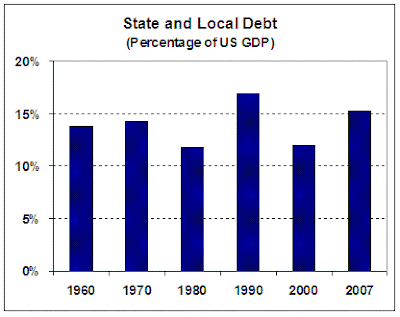Amaze your friends by demonstrating that all they need to know about market excesses during 2004-07, and their future course, can be seen in the palm of their hand.
Here's how...
Here's how...
Hold your hand up as if you were to perform a military salute. Think of your fingers as bars in a bar chart with your palm being the X axis and your fingers rising along the Y axis. See picture below.
 Point out that the four fingers are rising smartly above zero and that the thumb is "holding up" the X axis. You'll come to the thumb in a minute; first, identify the other fingers as "stocks", "bonds", "real estate" and "commodities", in no particular order. This was an unprecedented, "Everything Up" situation. As the economy and markets go through cycles, one or two of the "fingers" should be negative, e.g. stocks should rise and bonds drop during an expansion and vice versa, etc.
Point out that the four fingers are rising smartly above zero and that the thumb is "holding up" the X axis. You'll come to the thumb in a minute; first, identify the other fingers as "stocks", "bonds", "real estate" and "commodities", in no particular order. This was an unprecedented, "Everything Up" situation. As the economy and markets go through cycles, one or two of the "fingers" should be negative, e.g. stocks should rise and bonds drop during an expansion and vice versa, etc.
But not this time. Before the bottom dropped out of the credit market in mid to late 2007, every single "finger" was doing extremely well.
Lets' look at the "fingers" between January 2004 and August 2007 (all numbers approximate).
Floral gypsy dress (for the ladies) or Johnny Carson-type Carnac The Magnificent turban (for the gentlemen) strictly optional.
 Point out that the four fingers are rising smartly above zero and that the thumb is "holding up" the X axis. You'll come to the thumb in a minute; first, identify the other fingers as "stocks", "bonds", "real estate" and "commodities", in no particular order. This was an unprecedented, "Everything Up" situation. As the economy and markets go through cycles, one or two of the "fingers" should be negative, e.g. stocks should rise and bonds drop during an expansion and vice versa, etc.
Point out that the four fingers are rising smartly above zero and that the thumb is "holding up" the X axis. You'll come to the thumb in a minute; first, identify the other fingers as "stocks", "bonds", "real estate" and "commodities", in no particular order. This was an unprecedented, "Everything Up" situation. As the economy and markets go through cycles, one or two of the "fingers" should be negative, e.g. stocks should rise and bonds drop during an expansion and vice versa, etc.But not this time. Before the bottom dropped out of the credit market in mid to late 2007, every single "finger" was doing extremely well.
Lets' look at the "fingers" between January 2004 and August 2007 (all numbers approximate).
- S&P 500: +40%.
- US High Yield Corporate Bond Credit Spreads: Down from 360 bp to 250 bp (i.e. credit-worthiness way up).
- Case Schiller Home Price Index: +40%.
- Goldman Sachs Commodity Index: +33% (as of 1/2008 it is +66%).
- Total debt: +35% (includes all sectors, i.e. government, corporate, household, financial).
Floral gypsy dress (for the ladies) or Johnny Carson-type Carnac The Magnificent turban (for the gentlemen) strictly optional.


























